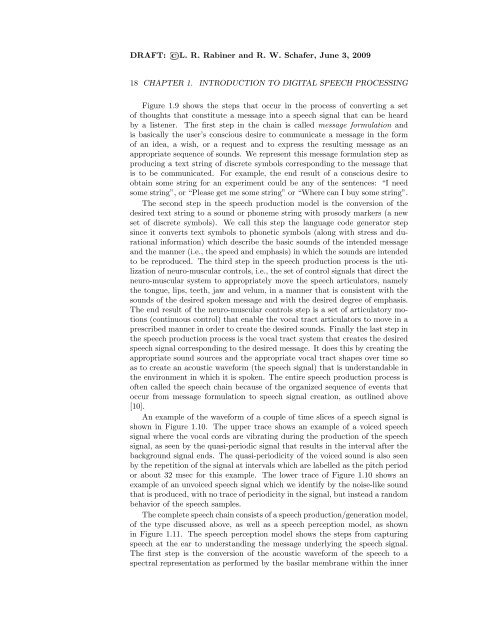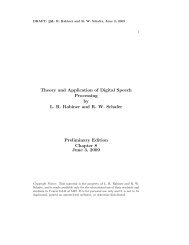Theory and Application of Digital Speech Processing by L. R. ...
Theory and Application of Digital Speech Processing by L. R. ...
Theory and Application of Digital Speech Processing by L. R. ...
Create successful ePaper yourself
Turn your PDF publications into a flip-book with our unique Google optimized e-Paper software.
DRAFT: L. R. Rabiner <strong>and</strong> R. W. Schafer, June 3, 2009<br />
18 CHAPTER 1. INTRODUCTION TO DIGITAL SPEECH PROCESSING<br />
Figure 1.9 shows the steps that occur in the process <strong>of</strong> converting a set<br />
<strong>of</strong> thoughts that constitute a message into a speech signal that can be heard<br />
<strong>by</strong> a listener. The first step in the chain is called message formulation <strong>and</strong><br />
is basically the user’s conscious desire to communicate a message in the form<br />
<strong>of</strong> an idea, a wish, or a request <strong>and</strong> to express the resulting message as an<br />
appropriate sequence <strong>of</strong> sounds. We represent this message formulation step as<br />
producing a text string <strong>of</strong> discrete symbols corresponding to the message that<br />
is to be communicated. For example, the end result <strong>of</strong> a conscious desire to<br />
obtain some string for an experiment could be any <strong>of</strong> the sentences: “I need<br />
some string”, or “Please get me some string” or “Where can I buy some string”.<br />
The second step in the speech production model is the conversion <strong>of</strong> the<br />
desired text string to a sound or phoneme string with prosody markers (a new<br />
set <strong>of</strong> discrete symbols). We call this step the language code generator step<br />
since it converts text symbols to phonetic symbols (along with stress <strong>and</strong> durational<br />
information) which describe the basic sounds <strong>of</strong> the intended message<br />
<strong>and</strong> the manner (i.e., the speed <strong>and</strong> emphasis) in which the sounds are intended<br />
to be reproduced. The third step in the speech production process is the utilization<br />
<strong>of</strong> neuro-muscular controls, i.e., the set <strong>of</strong> control signals that direct the<br />
neuro-muscular system to appropriately move the speech articulators, namely<br />
the tongue, lips, teeth, jaw <strong>and</strong> velum, in a manner that is consistent with the<br />
sounds <strong>of</strong> the desired spoken message <strong>and</strong> with the desired degree <strong>of</strong> emphasis.<br />
The end result <strong>of</strong> the neuro-muscular controls step is a set <strong>of</strong> articulatory motions<br />
(continuous control) that enable the vocal tract articulators to move in a<br />
prescribed manner in order to create the desired sounds. Finally the last step in<br />
the speech production process is the vocal tract system that creates the desired<br />
speech signal corresponding to the desired message. It does this <strong>by</strong> creating the<br />
appropriate sound sources <strong>and</strong> the appropriate vocal tract shapes over time so<br />
as to create an acoustic waveform (the speech signal) that is underst<strong>and</strong>able in<br />
the environment in which it is spoken. The entire speech production process is<br />
<strong>of</strong>ten called the speech chain because <strong>of</strong> the organized sequence <strong>of</strong> events that<br />
occur from message formulation to speech signal creation, as outlined above<br />
[10].<br />
An example <strong>of</strong> the waveform <strong>of</strong> a couple <strong>of</strong> time slices <strong>of</strong> a speech signal is<br />
shown in Figure 1.10. The upper trace shows an example <strong>of</strong> a voiced speech<br />
signal where the vocal cords are vibrating during the production <strong>of</strong> the speech<br />
signal, as seen <strong>by</strong> the quasi-periodic signal that results in the interval after the<br />
background signal ends. The quasi-periodicity <strong>of</strong> the voiced sound is also seen<br />
<strong>by</strong> the repetition <strong>of</strong> the signal at intervals which are labelled as the pitch period<br />
or about 32 msec for this example. The lower trace <strong>of</strong> Figure 1.10 shows an<br />
example <strong>of</strong> an unvoiced speech signal which we identify <strong>by</strong> the noise-like sound<br />
that is produced, with no trace <strong>of</strong> periodicity in the signal, but instead a r<strong>and</strong>om<br />
behavior <strong>of</strong> the speech samples.<br />
The complete speech chain consists <strong>of</strong> a speech production/generation model,<br />
<strong>of</strong> the type discussed above, as well as a speech perception model, as shown<br />
in Figure 1.11. The speech perception model shows the steps from capturing<br />
speech at the ear to underst<strong>and</strong>ing the message underlying the speech signal.<br />
The first step is the conversion <strong>of</strong> the acoustic waveform <strong>of</strong> the speech to a<br />
spectral representation as performed <strong>by</strong> the basilar membrane within the inner

















